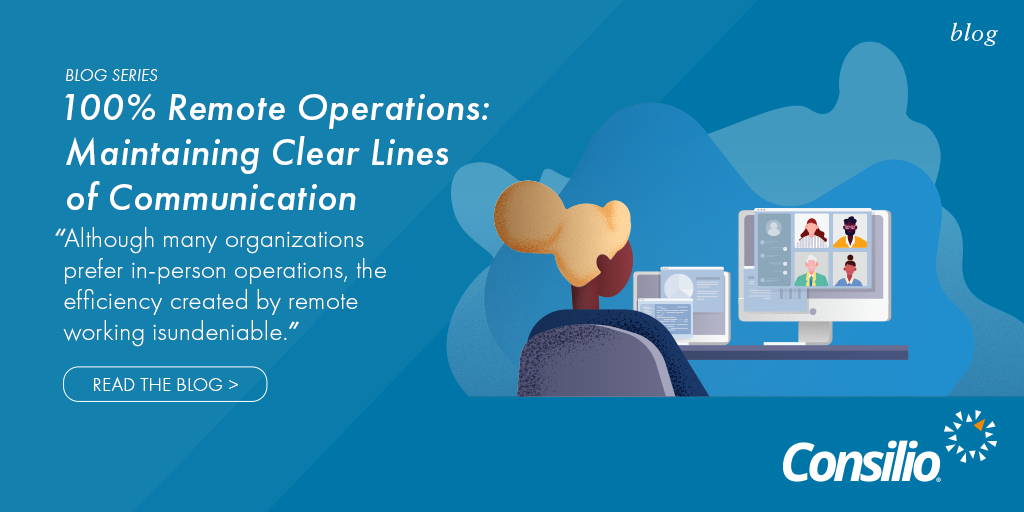This blog is part of our 100% Remote Operations: Working From Home series.
 Communicating with your coworkers is easy when they sit merely a couple of feet away from you. If you have a question, you can walk around the corner and pop into your boss’s office. Face-to-face discussion tends to be more impactful and, in many circumstances, is the preferred means of communication. This in-person communication aids in the building of rapport and trust through visual and audio psychological cues.
Communicating with your coworkers is easy when they sit merely a couple of feet away from you. If you have a question, you can walk around the corner and pop into your boss’s office. Face-to-face discussion tends to be more impactful and, in many circumstances, is the preferred means of communication. This in-person communication aids in the building of rapport and trust through visual and audio psychological cues.
The rapid spread of COVID-19 has forced millions of employees across the world to telecommute, many of which whom have little to no experience working outside the office. The truth of the matter is that certain aspects of regular communication are lost through virtual communication. On the contrary, there are also many ways in which virtual communication improves discussions and the flow of information. There are plenty of measures one can take, which normalize and effectively make virtual communication clear, concise, and efficient.
At some point during the typical workday, an employee must communicate with, collaborate with, or at least contact others. In this blog, we discuss the best technology and practices to help maintain clear lines of communication while working remotely.
Join the Virtual Meeting Through Video
On many virtual meeting platforms, users are given the option to join either through video or audio-only. While working in the comfort of your own home, it may be tempting to join by audio to avoid the necessary process of preparing to look the part. However, meeting through video allows for the much-needed contextualization provided by body language.
“I’m using videoconferencing much more lately, to maintain a visual connection with my colleagues and clients. Of course, that means fewer mornings working in my pajamas!”
Maureen O’Neill, Senior Vice President
Check-In
During a typical day in the office, you probably greet or talk with multiple people throughout the day. Obviously, working from home eliminates this aspect of office life. And, as telecommuting is new for many employees, it may feel disjointed and isolating. Checking in with your colleagues by sending them a brief message can make them feel more connected to the team. By feeling more connected, morale is boosted, which in turn increases productivity.
Share Often
Impromptu conversations, comments, and remarks are commonplace in the office. This type of commentary, of course, falls flat without the typical in-person audience. These quick interactions provide everyday context and background information, which can be lost in a remote setting. For this reason, continuing casual communication habits is encouraged. If you are questioning whether it would be important for a coworker to know any small detail or information, it is almost always better to share.
Share Correctly
Each organization has specific technology in place that they prefer to use to communicate. Whether its Slack, Skype, Google Hangouts, Asana, Trello, email, etc., it is also essential to decide which company communication platform is the best for certain contexts. It is also important to stick with the chat technology already in place by your company. In times of transition and urgency, blurring lines of communication by using too many different chat platforms can lead to confusion. Keep it simple, the fewer mediums you have to check, the better.
Instant chats should be reserved for off-the-cuff or casual comments. The matters discussed through instant chat should be brief and relatively simple. These could include checking availability for a meeting or sharing a reminder.
On the other hand, more significant matters or attachments can be shared via email. If several people must see the message, this is also the correct platform to use. Emails should be mainly focused on a single matter at hand, and generally stay concise.
Finally, virtual meetings or phone calls should be utilized when opening the table to discussion, brainstorming, and feedback. Matters discussed on these platforms will be more complex in nature, requiring more thought and resources.
Remote Communication Moving Forward
As millions across the world continue to work remotely, bridging communication gaps is a necessity. Many individuals have some experience of telecommuting, but it is crucial to continue to improve upon creating clear, open lines of communication. Further, a key takeaway is that although many organizations prefer in-person operations, the efficiency created by remote working is undeniable. Remote work opportunities have been steadily increasing over time, and this will continue at a rapid pace even when business operations return to normal. Virtual communication innately promotes efficient and concise data sharing, cutting down on any excess time spent communicating. As many organizations continue to employ individuals both in offices and remote, knowing how to communicate best using online technology will always be advantageous.